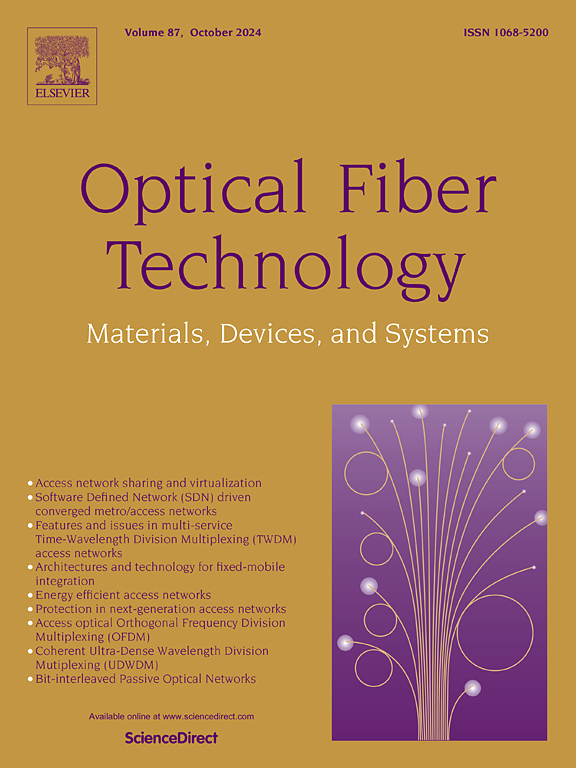Temperature sensitivity of cylindrical microresonators based on photonic crystal fiber
IF 2.7
3区 计算机科学
Q2 ENGINEERING, ELECTRICAL & ELECTRONIC
引用次数: 0
Abstract
This study considers the temperature sensitivity of cylindrical micro-resonators based on the whispering gallery mode. This structure uses photonic crystal fiber (PCF) infiltrated with nematic liquid crystal (NLC) as the sensor fiber, and multi-mode optical fiber (MMF) as the delivery fiber. The experiment involved exposing the cylindrical microresonator to temperatures in the range 32 °C to 63 °C. The free spectral range (FSR) of the micro-resonator was determined for different temperature ranges: 7.79 nm for 32–40 °C, 7.873 nm for 42–52 °C, and 11.479 nm for 52–63 °C. The Q factor was 103 for all temperature ranges. Due to the applied temperature, the micro-resonator tuning mechanism is based on the effective refractive index (RI) change. The sensor presented in this study exhibited sensitivities of −240 pm/°C for 32–40 °C, −253 pm/°C for 42–52 °C, and −271 pm/°C for 52–63 °C.
基于光子晶体光纤的圆柱形微谐振器的温度灵敏度
本文研究了基于窃窃廊模式的圆柱微谐振器的温度敏感性。该结构采用向列液晶(NLC)渗透的光子晶体光纤(PCF)作为传感器光纤,多模光纤(MMF)作为传输光纤。实验涉及将圆柱形微谐振器暴露在32°C至63°C的温度范围内。测定了微谐振器在不同温度范围内的自由光谱范围(FSR): 32-40°C为7.79 nm, 42-52°C为7.873 nm, 52-63°C为11.479 nm。在所有温度范围内,Q因子均为103。由于外加温度的影响,微谐振腔的调谐机制是基于有效折射率(RI)的变化。该传感器在32-40°C时灵敏度为- 240 pm/°C,在42-52°C时灵敏度为- 253 pm/°C,在52-63°C时灵敏度为- 271 pm/°C。
本文章由计算机程序翻译,如有差异,请以英文原文为准。
求助全文
约1分钟内获得全文
求助全文
来源期刊

Optical Fiber Technology
工程技术-电信学
CiteScore
4.80
自引率
11.10%
发文量
327
审稿时长
63 days
期刊介绍:
Innovations in optical fiber technology are revolutionizing world communications. Newly developed fiber amplifiers allow for direct transmission of high-speed signals over transcontinental distances without the need for electronic regeneration. Optical fibers find new applications in data processing. The impact of fiber materials, devices, and systems on communications in the coming decades will create an abundance of primary literature and the need for up-to-date reviews.
Optical Fiber Technology: Materials, Devices, and Systems is a new cutting-edge journal designed to fill a need in this rapidly evolving field for speedy publication of regular length papers. Both theoretical and experimental papers on fiber materials, devices, and system performance evaluation and measurements are eligible, with emphasis on practical applications.
 求助内容:
求助内容: 应助结果提醒方式:
应助结果提醒方式:


